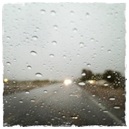Rain
 Rain is probably the bad weather condition you will drive in most. If you must travel on a regular basis, it’s hard to avoid the rain. Wet weather poses two main challenges. First, the roads become wet and slick. Second, in the case of downpours, your visibility may be very restricted, so much so that you may need to pull off the road until the heavy rain subsides.
Rain is probably the bad weather condition you will drive in most. If you must travel on a regular basis, it’s hard to avoid the rain. Wet weather poses two main challenges. First, the roads become wet and slick. Second, in the case of downpours, your visibility may be very restricted, so much so that you may need to pull off the road until the heavy rain subsides.
SOMETHING TO REMEMBER!
ROADS ARE THE SLICKEST FOR ABOUT ONE HALF HOUR AFTER IT BEGINS TO RAIN. LUBRICANTS AND OTHER CHEMICALS ON THE ROAD MIX WITH THE RAINWATER TO FORM A SLICK SURFACE COATING. ALWAYS USE EXTRA CAUTION IN WET WEATHER, BUT BE AWARE OF THAT MORE DANGEROUS FIRST HALF HOUR.
When driving in the rain, consider this:
- Allow more space between you and any lead vehicle.
- It will take longer for you to come to a safe stop. Hard stops may throw you into a skid.
- Remember to tap your brakes and slow, tap your brakes and slow, and repeat.
- Negotiate curves with extra caution. Make your turns smoother and more gradual than normal.
- Activate your headlights even if your visibility is farther than the recommended 500 feet for headlights.
- Remember, when your headlights are on, other people can see you. That’s what you always want in poor visibility conditions.
- Use your windshield wipers, set for the conditions. Intermittent wipers are good for showers or light rain. Set the wipers to steady on as rain gets heavier.
- If your wipers are actually hurting your visibility, safely pull off the road and attempt to find and fix the cause. Preflight checks help you discover worn or broken wiper blades. Have them replaced – a fairly easy and cheaper “do it yourself” task – as soon as possible.
- Never activate wipers immediately after rain begins. Built up dirt and grime will mix with initial rainfall and smudge your windows. Let enough rain fall to give the windshield a good soaking. Then clean the grime off with your wipers.
- Be extra vigilant when driving in the rain, especially in downpours. People walk in the rain. They also jog and cycle. Never assume the roadsides are clear just because it is raining.
Should you decide to ignore speed limits in the rain because you are in a hurry, there is one more thing you’ll want to learn about:
Hydroplaning
 When your vehicle hydroplanes, it is basically sliding across the surface of the road with no traction. While many people believe that hydroplaning occurs at about 50 to 55 mph, the process actually starts at 30 to 35 mph! As you drive along the wet surface of the road, your tire traction begins to deteriorate. This, of course, will be worse if your tires are worn. As your speed increases, your traction decreases. At some point, any number of things can cause you to fully hydroplane, losing all traction and control. A sharp turn, hard stop, or even a wind gust can push your vehicle off its course and into a hydroplaning situation.
When your vehicle hydroplanes, it is basically sliding across the surface of the road with no traction. While many people believe that hydroplaning occurs at about 50 to 55 mph, the process actually starts at 30 to 35 mph! As you drive along the wet surface of the road, your tire traction begins to deteriorate. This, of course, will be worse if your tires are worn. As your speed increases, your traction decreases. At some point, any number of things can cause you to fully hydroplane, losing all traction and control. A sharp turn, hard stop, or even a wind gust can push your vehicle off its course and into a hydroplaning situation.
Should you suddenly discover you are hydroplaning – you will definitely notice the complete loss of control – follow these steps:
- First, remain calm! Panic and irrational thought are your worst enemies here.
- DO NOT apply your brakes. Immediately ease up on the gas to slow down the vehicle.
- Keep your vehicle pointing straight ahead and avoid any turning unless it is not possible.
- If the back end of your vehicle begins to fishtail, turn into the skid. You will learn more about that a bit later.
- As your vehicle slows, your traction will improve. Once you feel you have regained control, continue normal travel.
- Evaluate what you did to cause the hydroplaning and adjust your driving accordingly.
- Put your passengers at ease if you have any.
